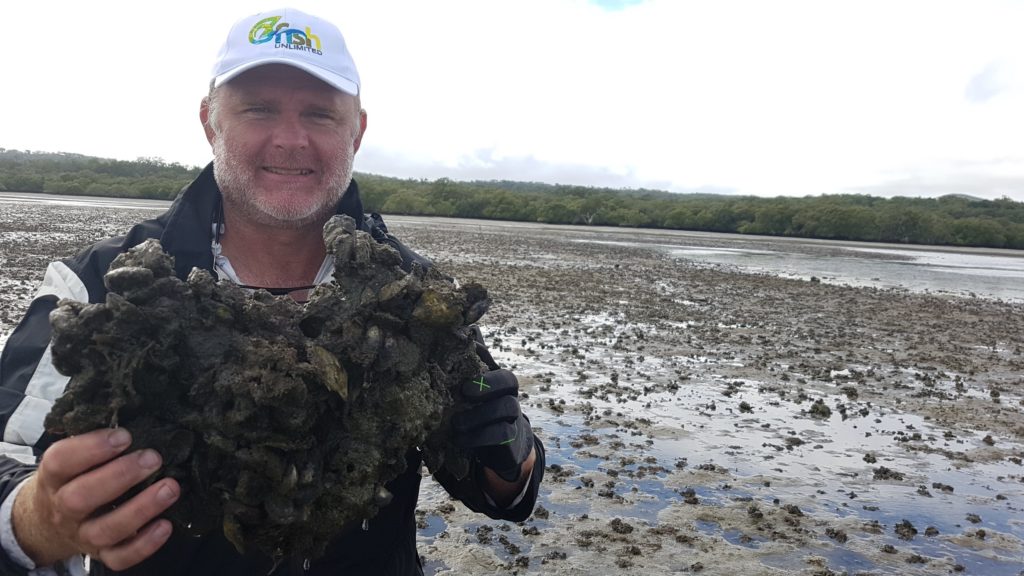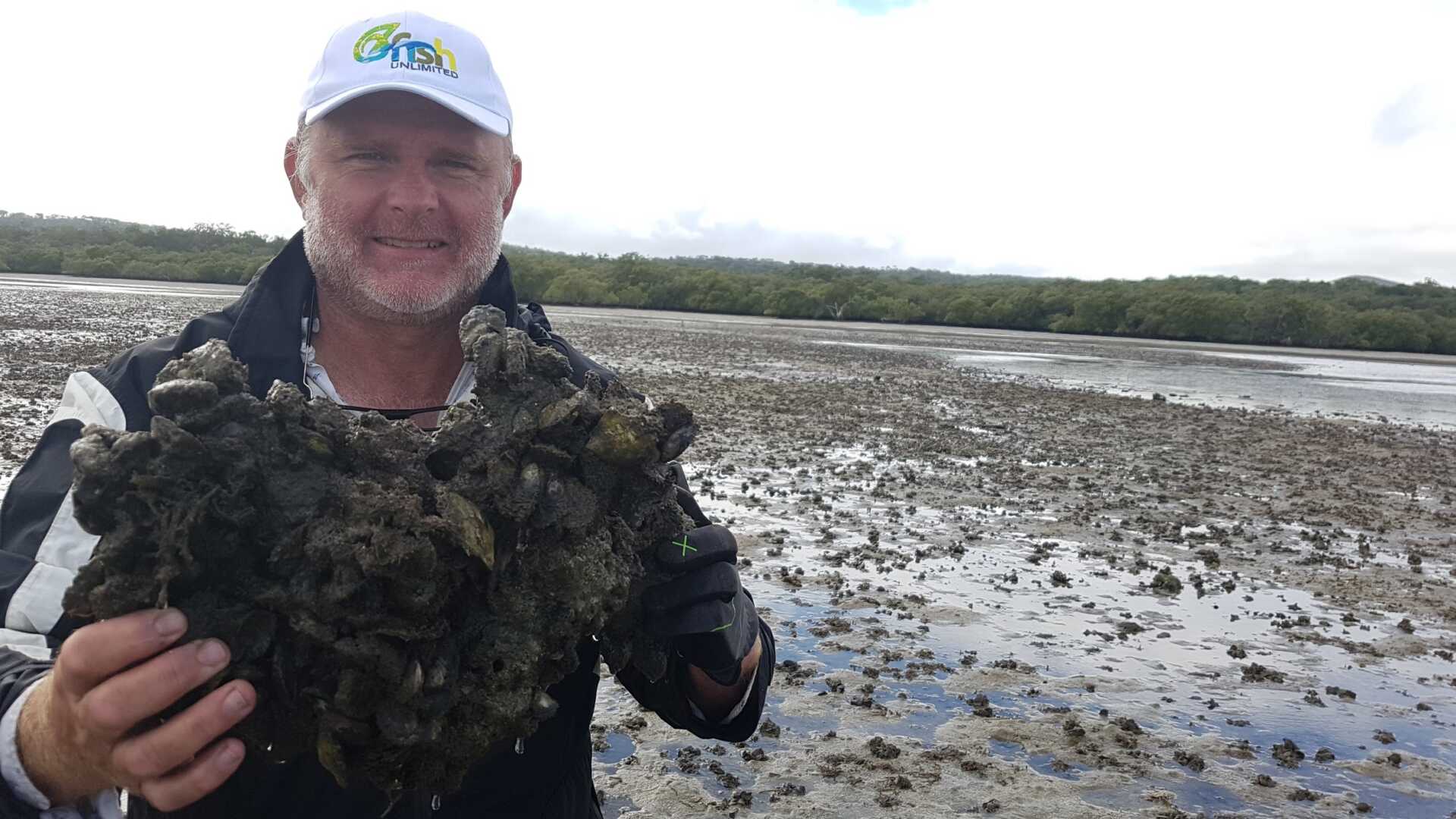Hitting The Refresh Button On Moreton Bay

Moreton Bay is a unique part of the world made famous for the bugs that carry its namesake. It should be a breadbasket of aquatic life fed by the warm Queensland currents. Instead, this unique stretch of coast has been ravaged by almost a hundred years of mining and poor water quality for which little environmental reparations have ever been made. What’s left is a coastal stretch that may look Instagram-worthy if you fly over it when leaving Brisbane, but when you get up close and personal it’s in a bad state. This is what the OzFish Unlimited Moreton Bay Chapter is working to remedy with its innovative shellfish habitat initiative.
The Inception Point

Leading the charge in this rehabilitation ascendency is OzFish Moreton BayChapter President, Robbie Porter, who grew up exploring and fishing the waterways of Moreton Bay. “Over the years I’d noticed how parts of the Bay are muddy and lifeless,” says Porter. “I always wondered why it had deteriorated so much then I researched the role shellfish play in water filtration and habitat. Without them the fish habitat and water quality will never be optimised and this dramatically affects fish stocks. I’d heard about other reef restoration projects around the world, mostly in America, and found out there were some happening in Queensland, but it’s become my goal to make this the biggest on the planet. Our goal is that in 10 years we will restore 100 hectares of Shellfish Reef and beyond that stretching many hundreds of hectares more.” Not only will that kind of restoration improve the water quality, but it will rejuvenate the aquatic life and return the Bay back to its former glory.
The Big Picture
National not-for-profit organisation OzFish Unlimited is partnered with leading retailer BCF, as part of its ‘Give Back to Habitat’ initiative to help projects like this in Moreton Bay. The opening of the Moreton Bay Shellfish Recycling Centre is just one part of the journey to restore Australia’s waterways to a healthy environment for aquatic life. Clean waterways and healthy habitats are vital for the sustainability of water related activities loved by Aussies, including recreational fishers. Placing used oyster shells after they have been sterilised by the recycling process, in the waterways is scientifically proven to encourage live oysters to return to the area, which has the knock-on benefit of growing fish populations. An adult oyster can filter between four and five litres of water every hour, meaning the restoration of shellfish reefs by OzFish will quickly make a demonstrable difference to the area’s water quality and fish populations. “What we’re doing here in Moreton Bay, which is just the start of a nationwide campaign, would not be possible without the dedication and support of our hardworking volunteers and partner organisations. I’d particularly like to thank BCF for their support and the national presence they give us.” said Mr Copeland OzFish CEO and founder.
Shells in Action
The OzFish Moreton Bay Chapter currently has 70 cubic meters of oyster shells drying and sterilising in the sun, but that’s only a portion of the raw materials they need to get the project up to full capacity. “Currently we’re only collecting a quarter of the shells from the oyster shucking industry and only 1% of the shells from restaurants and seafood business in the Brisbane area,” explains Porter. “It’s a matter of time and money because shells need to be regularly collected. The task is environmentally important because we are using the shells to create reefs instead of having them end up in landfill. We’re working on establishing a deal with the Eat Street Markets and hope to get the funding to employ someone full time to collect the shells which needs to happen every 2-3 days or they begin to stink.” Once these shells are sterilised in the sun they are placed into bags and will then be used to recreate the reefs we’ve lost.
[gdgallery_gallery id_gallery=”11″]
Test Sites
Moreton Bay is a Marine Park so OzFish is working with the Queensland Government to ensure its proposals do not harm the Bays existing values. OzFish Moreton Bay has already placed a test site outside the Park. “We placed a shellfish reef into a stretch of the Bay and found that there were an enormous populations of crabs, shrimp, bream, perch and mullet surrounding them,” says Porter. “The water was still muddy as it takes a while for new oysters to establish themselves, but it is positive to see new life where there was previously none.” They are aiming to create trial sites with an initial coverage of 13 tidal reefs and four subtidal reefs using the oyster shells nobody seems to want. It’s a pioneering initiative that will see new aquatic life and clearer water returned to the once glorious Moreton Bay area
How You Can Help
- Get the word out
Please share this story across your social platforms and put the idea in front of council and state members as we are getting some resistance against our conservation efforts.
- Volunteer and become a member
Contact Robbie Porter with a view for putting your name down to help. You can do this by becoming a member of the OzFish Moreton Bay Chapter online at ozfish.org.au/membership where you can support our work as a volunteer. Help with shell collection, bagging and other fish habitat projects is always welcome.
- Enter the Wynnum Fishing Classic (3-6th May)
Details are on the OzFish site www.ozfishmoretonbay.org and all proceeds will be devoted to the rehabilitation of the reef by way of buying bags to place the oyster shells into. There are raffles and plenty of prizes to be won to you won’t go home empty handed.
- Eat your fill of oysters
Specifically you should eat as many oysters as you can at the Wynnum Manly Seafood Festival (6th May) in George Clayton Park. All of the shells will be reused for the restoration project.
Donate to OzFish
Donations can be made via our website at ozfish.org.au or in-store at any BCF across the country through the ‘Give Back to Habitat’ Initiative.
